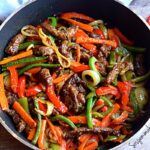Embark on a culinary journey that redefines your pantry and your health with the Banting diet. Imagine a space brimming with vibrant spices, healthy oils, and the promise of delicious, low-carb meals. This guide unveils the secrets to transforming your kitchen into a Banting haven, providing essential pantry staples, simple and advanced recipes, and meal planning strategies to effortlessly navigate this lifestyle change. Discover how to unlock a world of flavor while adhering to the principles of the Banting diet, resulting in a healthier and more vibrant you.
From understanding the core principles of the Banting diet and its restrictions to mastering essential cooking techniques and creating delicious, satisfying meals, this comprehensive guide provides everything you need to succeed. We’ll explore a carefully curated list of pantry staples, offering alternatives and showcasing their unique roles in Banting cuisine. We’ll then delve into a collection of both straightforward and more advanced recipes, perfect for all skill levels, ensuring a diverse and exciting culinary experience throughout your Banting journey. Finally, practical meal planning advice and portion control strategies will equip you with the tools to maintain a sustainable and enjoyable lifestyle change.
Banting Diet Basics

The Banting diet, named after the South African doctor William Banting, is a low-carbohydrate, high-fat (LCHF) eating plan that emphasizes whole, unprocessed foods. It focuses on significantly reducing carbohydrate intake while increasing the consumption of healthy fats and moderate amounts of protein. This approach aims to induce ketosis, a metabolic state where the body burns fat for energy instead of glucose.
Core Principles and Dietary Restrictions
The Banting diet’s core principle revolves around minimizing carbohydrate consumption to force the body into ketosis. This means drastically cutting out sugary drinks, refined carbohydrates like white bread and pasta, and starchy vegetables like potatoes. The diet encourages the consumption of healthy fats from sources like avocados, nuts, seeds, and olive oil, along with lean protein from meat, fish, and eggs. The restriction of carbohydrates aims to regulate blood sugar levels, promote weight loss, and potentially improve certain health markers.
Allowed and Restricted Food Groups
The following table illustrates the key distinctions between allowed and restricted food groups within the Banting diet framework. Understanding these distinctions is crucial for successful implementation.
| Food Group | Allowed | Restricted | Reasons for Restriction |
|---|---|---|---|
| Carbohydrates | Leafy green vegetables (e.g., spinach, kale), most berries in moderation, some non-starchy vegetables (e.g., broccoli, cauliflower, peppers) | Sugary drinks, refined grains (white bread, pasta, pastries), starchy vegetables (potatoes, corn), sugary fruits (bananas, mangoes) | High carbohydrate content leads to elevated blood sugar levels, hindering ketosis and potentially promoting weight gain. |
| Fats | Avocados, nuts (almonds, walnuts), seeds (chia, flax), olive oil, coconut oil, fatty fish (salmon, mackerel) | Processed vegetable oils (soybean, canola), trans fats | Processed and unhealthy fats can negatively impact cholesterol levels and overall health. |
| Protein | Lean meats (chicken, beef, turkey), fish, eggs, seafood | Processed meats (sausages, bacon – should be consumed sparingly) | Processed meats often contain high levels of sodium and preservatives. |
| Dairy | Full-fat dairy (cheese, yogurt, butter – choose unsweetened varieties) | Low-fat or skim dairy products | Full-fat dairy provides essential nutrients and satiety. |
Potential Health Benefits and Risks
The Banting diet, when followed correctly, may offer several potential health benefits. These include weight loss, improved blood sugar control in individuals with type 2 diabetes, and potentially reduced triglyceride levels. However, it’s crucial to acknowledge potential risks. These include nutrient deficiencies if not planned carefully, digestive issues like constipation, and the potential for kidney stones in individuals predisposed. Furthermore, the very low carbohydrate intake may lead to fatigue and difficulty exercising in the initial stages. It’s vital to consult a healthcare professional or registered dietitian before starting any restrictive diet, especially if you have underlying health conditions. A personalized approach ensures that nutritional needs are met and potential risks are minimized.
Meal Planning and Portion Control for Banting
Successful Banting requires careful planning and mindful portion control. A well-structured meal plan ensures you receive adequate nutrients while adhering to the diet’s low-carbohydrate, high-fat principles. Understanding portion sizes is crucial to avoid overeating and achieving your weight management goals.
Sample Weekly Banting Meal Plan
This sample meal plan provides a visual representation of how to incorporate Banting principles into your daily routine. Remember to adjust portion sizes based on your individual caloric needs and activity levels. Recipe details are provided for illustrative purposes; you can easily substitute with other Banting-friendly options.
| Day | Breakfast | Lunch | Dinner |
|---|---|---|---|
| Monday | Scrambled eggs (2) with spinach and feta cheese (50g), avocado (½) | Chicken salad (150g grilled chicken, mixed greens, olive oil dressing) | Salmon (150g) baked with asparagus and a knob of butter |
| Tuesday | Chia seed pudding (made with coconut milk and berries) | Leftover salmon and asparagus | Steak (150g) with cauliflower mash and green beans |
| Wednesday | Coconut yogurt (150g) with nuts and seeds | Tuna salad (made with mayonnaise, celery, and onion) in lettuce wraps | Pork chops (2) with broccoli and a side salad (olive oil and vinegar dressing) |
| Thursday | Omelette (3 eggs) with mushrooms and cheese | Leftover pork chops and broccoli | Chicken stir-fry (using coconut aminos and plenty of vegetables) |
| Friday | Full-fat cottage cheese (150g) with berries | Salad with grilled halloumi cheese (100g) and olives | Steak and eggs |
| Saturday | Bacon and eggs (2) | Leftover chicken stir-fry | Roast chicken (150g) with roasted root vegetables |
| Sunday | Avocado and cream cheese on a slice of Banting bread (made with almond flour) | Leftover roast chicken and vegetables | Ground beef (150g) and zucchini noodles with tomato sauce |
Strategies for Maintaining Portion Control
Effective portion control involves mindful eating and understanding your body’s hunger and fullness cues. Visual cues, such as using smaller plates and bowls, can help manage portion sizes. Preparing meals in advance can also aid in controlling portions and preventing impulsive unhealthy food choices. Paying attention to satiety signals, slowing down your eating pace, and drinking plenty of water are all helpful strategies. Weighing and measuring food initially can be beneficial in establishing a baseline understanding of appropriate serving sizes.
Common Challenges and Solutions
One common challenge is the initial adjustment period, as individuals may experience cravings or fatigue. Gradually introducing the diet and focusing on nutrient-dense foods can help mitigate these effects. Another challenge is social situations involving non-Banting meals; planning ahead and bringing Banting-friendly options can alleviate this. The potential for nutrient deficiencies can be addressed by focusing on a wide variety of vegetables, healthy fats, and protein sources. Finally, the higher cost of some Banting-friendly ingredients can be managed through smart shopping and meal planning, focusing on seasonal and affordable options.
Unlocking the potential of the Banting diet begins with a well-stocked pantry and a clear understanding of its principles. This guide has equipped you with the essential knowledge and recipes to embark on this transformative culinary adventure. By embracing the simplicity of the basic recipes and challenging yourself with the more advanced ones, you’ll not only nourish your body but also cultivate a newfound appreciation for healthy, flavorful cooking. Remember, consistency and mindful planning are key to success. So, step into your transformed Banting kitchen and savor the delicious journey ahead!
FAQ Resource
What are some common Banting diet pitfalls to avoid?
Common pitfalls include insufficient planning, leading to reliance on processed low-carb alternatives, and neglecting essential micronutrients. Strict adherence without adequate nutrient monitoring can also lead to deficiencies.
Can I still enjoy treats on the Banting diet?
Yes, many Banting-friendly desserts and treats exist using alternative sweeteners and low-carb ingredients. Moderation is key.
How long does it take to see results on the Banting diet?
Results vary depending on individual factors, but many people see improvements in energy levels and weight within a few weeks of consistent adherence.
Is the Banting diet suitable for everyone?
No, it’s crucial to consult your doctor before starting the Banting diet, especially if you have pre-existing health conditions.


